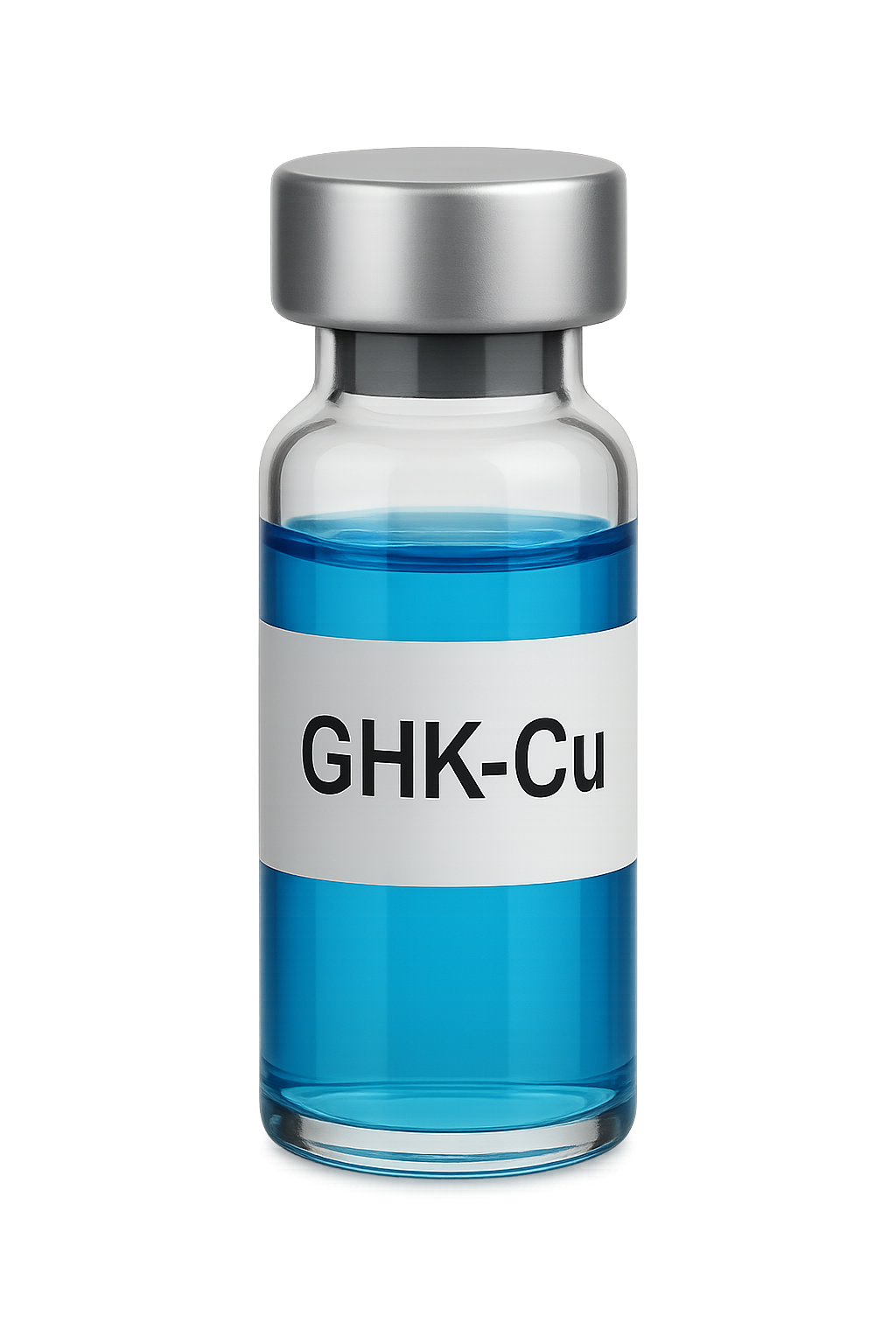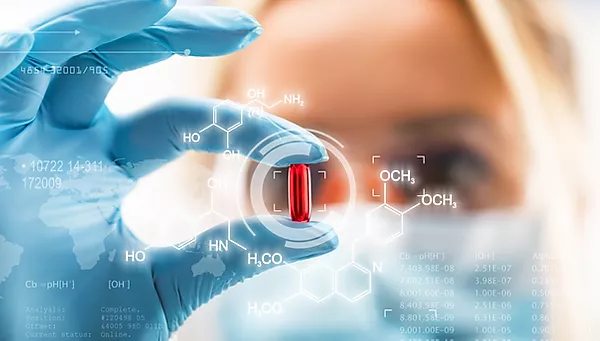Abstract
- GHK (glycyl-L-histidyl-L-lysine) is present in human plasma, saliva, and urine but declines with age.
- Proposed to function as a copper 2+ complex (GHK-Cu) that accelerates wound healing and skin repair.
- Stimulates both synthesis and breakdown of collagen and glycosaminoglycans.
- Modulates metalloproteinases and their inhibitors.
- Attracts immune and endothelial cells to sites of injury.
- Accelerates wound healing in skin, hair follicles, gastrointestinal tract, bone tissue, and animal models.
- Cosmetic applications: tighten skin, improve elasticity, reduce wrinkles, improve density and firmness, reduce photodamage and hyperpigmentation.
- Therapeutic potential: skin inflammation, COPD, metastatic colon cancer.
- Can up- or downregulate at least 4,000 human genes—essentially resetting DNA to a healthier state.
Explanatory note: “Declines with age” supports positioning GHK as a pro-rejuvenation signal that may help counter age-related repair deficits.
Mechanistic context: Collagen/GAG turnover balance suggests remodeling—not just stimulation—reducing risk of disorganized matrix.
Gene-level reset: The 4,000-gene modulation claim implies network-wide influence on repair, inflammation, and oxidative stress pathways.
1. Introduction
GHK sequence: glycyl-histidyl-lysine.
This short, naturally occurring tripeptide was first identified in human plasma, but it is also present in saliva and urine, highlighting its role as an intrinsic regulator of human physiology.
Natural occurrence and age-related decline.
Average plasma levels measure around 200 ng/mL at age 20, but fall to ~80 ng/mL by age 60. This ~60% reduction has been linked to diminished stem cell activity, slower extracellular matrix (ECM) turnover, and overall reduced regenerative capacity of skin and connective tissues.
Discovery and early research.
First isolated in 1973, GHK was shown to stimulate protein synthesis in aged liver tissue, sparking decades of investigation into its regenerative and reparative effects.
Copper binding and the GHK-Cu complex.
GHK has a particularly strong affinity for copper ions, binding Cu(II) to form the GHK-Cu complex. This complex not only ensures safe transport of copper—a vital enzymatic cofactor—but also prevents oxidative stress that can arise from free copper ions.
Key biological functions.
Accelerates wound healing by attracting immune cells and promoting collagen remodeling.
Improves success of transplanted skin grafts through better tissue integration and reduced rejection risk.
Exerts anti-inflammatory effects that temper early wound-phase responses, helping control scarring and enhance the quality of repair.
Mechanistic insights.
The plasma decline with age explains why older tissues often heal more slowly and less efficiently.
Copper affinity underscores GHK-Cu’s role as both a safe metal transporter and a signaling molecule.
Anti-inflammatory properties position GHK-Cu as a natural regulator of the wound environment, capable of balancing repair and scar formation.
2. GHK Restores TGF-Beta Pathway in COPD Lungs
- COPD: emphysema, inflammation, tissue destruction, reduced lung capacity.
- 127 genes identified with expression tied to emphysema severity.
- GHK reversed gene expression signatures, restoring TGF-beta activity.
- In vitro: GHK treatment restored fibroblast ability to contract and remodel collagen gel.
- Increased expression of integrin beta 1.
- Key implication: GHK activates both TGF-beta and integrin beta 1 pathways → improves tissue regeneration.
- Connectivity Map: Signature reversal indicates network-level correction rather than single-target effects.
- Matrix mechanics: Restored collagen gel contraction mirrors fibroblast competency required for dermal remodeling.
- Clinical signal: Supports rationale for GHK in disorders featuring impaired matrix turnover.
3. Cancer Metastasis Genes and Skin Remodeling
Genome-wide profiling identified GHK as a modulator of colorectal cancer metastasis genes.
Findings:
- Suppressed RNA production in 70% of 54 genes linked to metastatic colon cancer.
- Effective at low concentration (1 μM).
- Reset gene activity to healthier state.
Additional studies:
- Induced apoptosis in neuroblastoma, histolytic, and breast cancer cells.
- With ascorbic acid, GHK-Cu inhibited sarcoma-180 in mice.
Node molecules: Reversal across network hubs (e.g., MAP3K5, NFATC2) suggests broad regulatory reach.
Dose perspective: Micromolar efficacy aligns with feasible topical delivery and potential systemic strategies.
Skin tie-in: Agents that normalize metastasis signatures often favor orderly dermal remodeling.
4. Recovery of Skin Stem Cells
Skin regeneration relies on basal keratinocyte stem cells.
GHK-Cu (0.1–10 μM):
- Increased expression of integrins and p63 (stemness markers).
- Indicated improved proliferative potential.
Mesenchymal stem cell study:
- Pretreatment with GHK increased VEGF and bFGF secretion.
- Effects blocked by integrin antibodies → integrin pathway involvement.
Epidermal renewal: p63 elevation correlates with basal layer maintenance and youthful turnover.
Paracrine boost: VEGF/bFGF secretion may support angiogenesis and fibroblast activity.
Adhesion cues: Integrin signaling couples mechanical anchoring with gene programs for repair.
5. GHK and IL-6 in Skin Repair
Wound healing involves inflammation, proliferation, and matrix remodeling.
Excessive inflammation → delayed healing, scarring.
GHK-Cu reduced TNF-alpha induced IL-6 secretion.
Proposed as topical anti-inflammatory alternative to corticosteroids.
IL-6 throttle: Dampening IL-6 can reduce catabolic signaling and edema, aiding cleaner granulation tissue.
Steroid-sparing idea: Potential to reduce steroid exposure in mild inflammatory dermatoses (context dependent).
6. GHK and DNA Repair
GHK restored irradiated fibroblast viability.
Results:
- Faster growth similar to intact fibroblasts.
- Higher production of growth factors.
- Stimulated expression of 47 DNA repair genes, suppressed 5.
Damage response: Profiles align with enhanced nucleotide/base excision, checkpoint control, and chromatin remodeling.
Clinical angle: May support photo-damaged skin protocols when paired with UV avoidance and antioxidants.
7. Facial Studies
Clinical studies (women ~50 years old):
- Increased collagen production (70% with GHK vs 50% vitamin C, 40% retinoic acid).
- Reduced signs of aging after 12 weeks.
- Improved skin density, thickness, laxity, and clarity.
Placebo-controlled eye cream study: GHK-Cu outperformed vitamin K.
Documented cosmetic effects:
- Tightens loose skin.
- Improves elasticity, density, firmness.
- Reduces fine lines and wrinkles.
- Improves clarity, reduces photodamage.
- Stimulates keratinocyte proliferation.
Protocol tip: Combine with daily sunscreen and gentle retinoid alternation for complementary remodeling.
Outcome tracking: Use standardized photo angles & glossmeters for objective improvements.
8. Formulation and Delivery
GHK-Cu can penetrate stratum corneum.
Susceptible to proteolytic enzymes → requires sustained delivery systems.
Delivery methods studied:
- Biotinylated peptide collagen matrices.
- Niosomes and microparticles.
- Hydroxypropyl cellulose compression-coated tablets (colon delivery).
- Liposomes and oral carriers for systemic effects.
Stability tactics: pH tuning, chelation control, and protease-shielded complexes can extend activity.
Texture & feel: Water-gel matrices with humectants can enhance user experience without occlusion.
Patch viability: Reservoir patches or dissolving microneedles may enhance dose control.
9. Breakdown Resistant Mixed Copper Peptide Complexes
Infected wounds: bacteria release proteases that degrade peptides.
Mixed copper peptide complexes (resistant to breakdown) showed significant healing activity.
Tested in human wound healing models:
- Faster recovery in skin lipid removal, chemical irritation, tape stripping, and nickel allergy cases.
Clinical implication: Enzyme-resistant designs can sustain signaling in protease-rich environments.
Use case: Adjunct in chronic wound clinics alongside debridement and moisture balance.
10. Biochemistry of GHK-Cu
Structure studied with X-ray crystallography, spectroscopy.
Cu(II) ion coordination:
- Imidazole nitrogen (histidine).
- Alpha-amino nitrogen (glycine).
- Amide nitrogen (glycine-histidine bond).
Features:
- Forms binary/ternary structures.
- Efficient copper binding and transport.
- Prevents oxidative damage by reducing free ionic copper.
- Acts as antioxidant and cell adhesion molecule.
Copper economy: Supports redox homeostasis; key for enzymes like lysyl oxidase and superoxide dismutase.
Adhesion facet: May influence integrin clustering and cell–matrix interactions during repair.
11. GHK: A Built-In Natural Regulator of Dermal Repair
Wound healing phases: hemostasis, inflammation, granulation, scar remodeling.
Growth factors from platelets, keratinocytes, fibroblasts, immune cells.
GHK present in ECM proteins (e.g., collagen type I alpha 2 chain, SPARC).
Released upon proteolysis at wound site.
Acts as a matrikine, regulating repair by resetting gene patterns.
Endogenous origin: In-situ release links injury detection to immediate signaling without external dosing.
Network effect: Coordinates cross-talk between cytokines, growth factors, and integrin/TGF-β axes.
12. Conclusion
GHK-Cu enhances dermal healing and skin renewal.
Research demonstrates that GHK-Cu not only accelerates wound closure but also improves the quality of repair by stimulating collagen and elastin production, supporting healthier extracellular matrix remodeling, and reducing the risk of scarring.Resets disrupted cellular pathways to a healthier state.
By influencing thousands of genes simultaneously, GHK-Cu is able to “reset” cells that have been damaged by age, oxidative stress, or inflammation, bringing their activity closer to youthful, balanced patterns.Safe, abundant, low-cost therapeutic candidate.
GHK is naturally present in human plasma, saliva, and urine, and decades of studies have shown it to be safe, non-toxic, and inexpensive to produce—making it highly attractive as a therapeutic and cosmetic ingredient.Potential for systemic healing at ~100–200 mg dose.
Beyond topical use, systemic administration in this range has been proposed to support broader healing responses throughout the body, from connective tissue regeneration to improved organ repair capacity.Delivery methods under investigation include:
Topical gels – easy to apply, widely used in cosmetic and dermatology formulations.
Dermal patches – enable sustained release directly into targeted skin areas.
Collagen membranes – can integrate GHK-Cu into wound dressings or surgical applications.
Oral carriers – designed to bypass digestive breakdown and deliver systemic benefits.
Final takeaway:
GHK is a naturally occurring, built-in regulator of skin repair. Its ability to reset cellular signaling, support balanced tissue remodeling, and reduce inflammation makes it a powerful candidate for both medical treatments and everyday cosmetic care.Positioning statement:
“Resets cellular signaling, supports balanced remodeling, and aligns with anti-inflammatory skin care.”Next steps for practical use:
Incorporate GHK-Cu into a layered skin-care or therapeutic protocol. For optimal results, pair it with sunscreen to protect against UV damage, barrier-repair strategies (such as ceramides and moisturizers) to strengthen skin defenses, and measured active ingredients like retinoids or antioxidants to achieve comprehensive, synergistic benefits.






